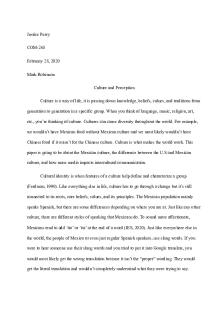Essay PLAN - FACE Perception PDF

| Title | Essay PLAN - FACE Perception |
|---|---|
| Course | Developmental Psychology |
| Institution | Newcastle University |
| Pages | 4 |
| File Size | 189.2 KB |
| File Type | |
| Total Downloads | 85 |
| Total Views | 140 |
Summary
Face perception detailed essay plan...
Description
FACE PERCEPTION
Sensation = information about the environment picked up from sensory receptors and transmitted to brain Perception = interpretation by the brain of these inputs
VISUAL ACUITY Poor at birth, rapid increase in first 6 months Near adult levels by 1 year VISUAL SCANNING Younger than 2 months = can’t track object smoothly 1 month = focus on limited features of a shape e.g outside edges 2 months = start to focus on internal features COLOUR VISION New-borns can distinguish between red and white but no other colours 1 month = look longer at bright bold colour 4 months = similar to adult abilities HOW DO WE TEST PERCEPTUAL ABILITIES? Preference tests Habituation tests Conditioning PREFERENCE TESTS Present 2 stimuli and measure how long baby looks at each – if looks at one for longer = has s preference and can distinguish between the 2 stimuli Fantz (1961) Looked at orange longer than white circle, looked at face longest, and next text detail
HABITUATION TESTS Shown interesting stimulus repeatedly (eventually infant loses interest = habituation) Change to a different stimulus – infant shows renewed interest and looks again (dishabituation) Shows infant can tell the difference CONDITIONING Repeatedly reward target behaviour (increased sucking rate – get specific stimuli) Infant becomes habituated to stimulus, stimulus is altered If infant does not increase sucking rate, treats 2 stimuli the same Does increase sucking rate = distinguishes between the 2 stimuli Moulson et al (2009, p.1) “Faces are arguably the most important visual stimulus used in human social communication” Face perception = crucial ability for successful social life (can depict species, sex, race, identity, mood etc)
THEORETICAL APPROACHES
Nature vs nurture Nativism: abilities from birth – innate, inborn o Descartes (1638/1965) and Kant (1781/1958) argued that infants’ capacity to perceive space is innate o Gestalt school – (early 20th century) – certain perceptual abilities were present at birth because of the structural characteristics of the NS – the infant actively tries to create order and organisation in their perceptual world Empiricism: acquire overtime through experience – learned o William James (1890) – to the infant sensory inputs become fused into “one blooming, buzzing confusion” – only later through experience that children can discriminate among them o John Locke - tabula rasa (blank slate) on which experience is imprinted Special perceptual process for faces Organised at birth Perceive faces as the perceive other objects Becomes specialised after experience
Fantz (1961) - Innate face preference 1-15 weeks old = prefer complex patterns 2 faces with facial features were preferred to blank face
Maurer & Barrera (1981) – add controls for complexity 1 month = no difference in looking times 2 months = looked longer at ‘natural’ face
Goren et al (1975) Used moving stimuli instead of static New-borns tracked schematic face more than the other two
EARLY FACE PREFERENCE? Johnson et al (1991) Replicated effect with new-borns By 3 months – no longer track face more Why does this face preference vanish?
Johnson & Morton (1991) – 2 process model CONSPEC = early system (subcortical structures) biases infants to orient towards face CONLEARN = later taken over by more mature system (visual cortex) and more precise recognition
NEW-BORN ABILITIES Recognise identity of novel individuals (Turati, 2008) Recognise eye-gaze – look more at direct than averted eyes (Farroni, 1982)
Recognise expressions – infants dishabituated when expression changes (Field, 1982) Prefer attractive faces – new-borns < 1 week old, looked longer at attractive faces (Slater, 2000) Discriminate mother’s face – 1-4 days old sucked more to keep mother’s face on video (Walton, 1992) Pascalis (1995) – disappearance for mother’s face disappeared when outside of face/hairline was masked, new-borns use outer features to identify)
Turati (2006) – could use both outer and inner features, but better with full-face condition with inner and outer features present or just outer features alone compared to inner features alone
Suggests face perception must be innate to some extent in new-borns Support: Sugita (2008) - monkeys not exposed to faces for first few months of life still preferred them (early maturation support)
EFFECT OF ENVIRONEMNT – EARLY SOCIAL EXPERIENCE
As we get older face perception skills become more specialised (narrowing of perpetual window)
Pascalis (2002) 6m old infants could discriminate between monkey faces and human faces (dishabituate) 9m old and adults could only discriminate between human faces
“OTHER RACE EFFECT” Adults are poorer at discriminating faces of races different from their own Tanaka (2004) – driven by environment, due to exposure to similar races in one’s environment 3m old (not new-borns) prefer own race face (Kelly, 2005) Sangrigoli (2005) Korean adults adopted between 3-9months into Caucasian families More accurate with Caucasian faces (distinguishing)
Better at discriminating and recognising female faces (effect of exposure to primary care giver?) Preference for female faces in 3m old infants, not new-born (Quinn, 2008) Fathers as primary caregivers = preference for male faces (Quinn, 2002)
Institutionalised children showed deficits in identifying emotions in faces (Wismer Fries & Pollack, 2004) Children raised in an abusive environment show bias for angry faces (Polack, 2000)
BEYOND INFACNY – CONTINUING DEVELOPMENT IN ADULTS
Recognise faces as familiar in 0.5s Retain information about a large number of faces 90% recognition of yearbook photos (class size up to 300, 35 years later) Some research suggests expertise (face learning/recognition) doesn’t fully emerge until 30+ years
LATE MATURATION VS EARLY MATURATION Two key theories: Face specific perceptual development theory = ongoing development of face-specific perception mechanisms continue to develop into late childhood/adolescence SUPPORT: Susilo, 2013 Tested over 2,000 18-33-year olds Positive association between age and facial recognition abilities, other abilities increase over time Controlled for non-face visual recognition, sex, own-race bias
General cognitive development theory = face perception matures early (4-5 years), performance increases later as general cognitive mechanisms improve
Holistic/configural processing = integration of information from all regions of the face, code spacing between face and features
ABORMAL FACE PERCEPTION ASD = deficits in social cognition (recognising familiar people, remembering faces, interpreting eyegaze/emotions) William’s syndrome = process unfamiliar face atypically, prolonged face gaze (Riby, 2008) Prosopagnosia (face blindness) = damage or abnormalities in right fusiform gyrus, congenital prosopagnosia (from birth, appears to run in families) – differs in severity (e.g might not recognise own face) PASCALIS (2011) •
Tzourio-Mazoyer et al – using PET technique found brain activation in 2-month-old infants presented with faces in brain regions that are activated by faces in an adult population in both fMRI and PET studies.
•
Golarai et al - compared recognition of objects and faces in children (ages 7–11), teenagers, and adults. o found similar activation in the same areas for the three age groups for objects. o For faces - demonstrated that FFA is three times larger in adults than in children which may explain why some studies could not find it in young children.
•
Viewing a face triggers at least two automatic and fast processes o categorization of the stimulus as a face belonging or not belonging to our own group or species o recognition of the face at an individual level Bruce and Young - stepwise model where categorization of faces according to their race, gender, and other social attributes happens at an early stage of ‘structural encoding’, before the ‘face recognition units’ or the ‘person identity nodes’ are involved
•...
Similar Free PDFs

Essay PLAN - FACE Perception
- 4 Pages

Week 11 Face Perception
- 5 Pages

Culture and perception essay
- 6 Pages

Culture and Perception Essay
- 6 Pages

Doll Face - Doll face
- 2 Pages

Perception
- 3 Pages

PERCEPTION
- 10 Pages

Face to Face #3 - Solutions
- 4 Pages

BABY FACE
- 1 Pages

Self Care Plan Essay
- 4 Pages

Blood Donation Essay Plan
- 4 Pages

Water Crisis Essay Plan
- 3 Pages

Soft Determinism Essay Plan
- 2 Pages
Popular Institutions
- Tinajero National High School - Annex
- Politeknik Caltex Riau
- Yokohama City University
- SGT University
- University of Al-Qadisiyah
- Divine Word College of Vigan
- Techniek College Rotterdam
- Universidade de Santiago
- Universiti Teknologi MARA Cawangan Johor Kampus Pasir Gudang
- Poltekkes Kemenkes Yogyakarta
- Baguio City National High School
- Colegio san marcos
- preparatoria uno
- Centro de Bachillerato Tecnológico Industrial y de Servicios No. 107
- Dalian Maritime University
- Quang Trung Secondary School
- Colegio Tecnológico en Informática
- Corporación Regional de Educación Superior
- Grupo CEDVA
- Dar Al Uloom University
- Centro de Estudios Preuniversitarios de la Universidad Nacional de Ingeniería
- 上智大学
- Aakash International School, Nuna Majara
- San Felipe Neri Catholic School
- Kang Chiao International School - New Taipei City
- Misamis Occidental National High School
- Institución Educativa Escuela Normal Juan Ladrilleros
- Kolehiyo ng Pantukan
- Batanes State College
- Instituto Continental
- Sekolah Menengah Kejuruan Kesehatan Kaltara (Tarakan)
- Colegio de La Inmaculada Concepcion - Cebu


